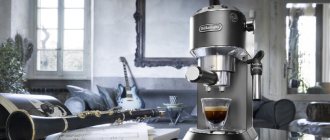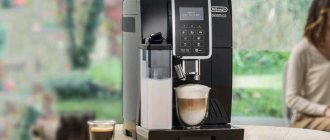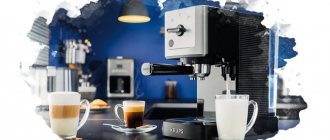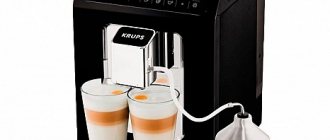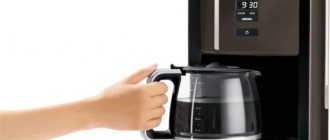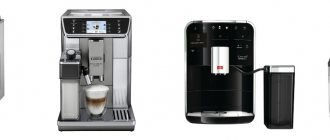Coffee, a drink that is very popular. Every second person prefers to drink natural coffee. The taste of coffee may depend on the intensity of roasting of the beans. Therefore, special devices are provided in which frying is carried out evenly. Roasters are often used in coffee shops. However, small models can be purchased for home use. In order to choose the right device, you need to study popular models that have repeatedly proven their quality. The rating of the best coffee roasters, compiled according to users, for 2022 describes the advantages and disadvantages of the models, making it easier to choose.
Why roast beans at home?
Coffee that has been roasted in advance can be delicious. However, even the best coffee beans begin to lose their rich taste and aroma a short time after roasting. If you want to make real coffee at home, it's time to get your own roaster. Then you can enjoy fresher and tastier coffee.
Don't want to read? You can't go wrong with a Nesco roaster. It is easy to use and can roast large quantities of beans.
The best coffee roasters
Thanks to us, you won't have to do fortune-telling using coffee grounds. We have selected several coffee roasters that have all the necessary functions. My pleasure.
Roaster for coffee beans Nesco CR-10-10-PR
If you have a lot of coffee lovers in your house who are eager to get their morning cuppa, then you're probably already into roasting yourself.
You can simplify things if you use this roaster. It can roast up to 142 g of coffee beans at a time. This will make enough for 36 cups of coffee - although this depends on how many beans you use for your coffee. After all, it could be one very large mug consumed before an office meeting on Monday at 8am. Nesco CR-10-10-PR has advanced odor and smoke elimination features, so you won't feel like you're in Firestorm while roasting. It is easy to load beans into the roasting chamber, and the menu controls are simple and intuitive. This machine is a great choice for those just getting into roasting or those taking it to the next level after previously popping beans in a popcorn maker or manual model.
Approximate cost: $137.00
Drum roaster Behmor Plus Customizable
You may have been at your local coffee shop and marveled at the drum roasters and the wonderful smell that came from the machines.
Of course, you can build such a machine yourself, and you can also bring home this neat and relatively small roaster from Behmor. This machine is the size of a small microwave. It is slightly larger than other, cheaper coffee roasters.
But you can roast up to 454 g of coffee beans at a time. If you make and drink many servings of coffee per week, then this model will save you time and effort. The device contains a smoke elimination system and also has five different roasting cycles. The roasting chamber is illuminated so you can observe the coffee beans.
Approximate cost: $399.00
Automatic roaster for coffee beans FreshRoast SR500
Are you short on kitchen space but still want to roast beans at home?
Set aside some space in your kitchen for the FreshRoast SR500. Despite its modest size, the device has many functions. For example, it has a fan whose speed can be adjusted, as well as three temperature settings.
This model allows you to roast 90 g of coffee at a time. That's 21 cups of coffee, so you can invite friends over without worrying about roasting extra coffee. Combined with uncomplicated operation and easy cleaning, you get a roaster that is ideal for small coffee brewing spaces.
Approximate cost: $189.00
Manual ceramic roaster for coffee beans Nuvo Eco
After a good coffee, just like after exercise, you feel energized.
Why not combine roasting coffee with a moderate-intensity workout? To make delicious roasted beans in the Nuvo Eco Ceramic Manual Roaster, you only need two things: fire and the desire to move around while roasting. Up to 70 g of beans are placed in this manual roaster at a time, and they are roasted over an open fire. Of course, such volumes will not be enough for a crowd, but you will have fun in the morning thanks to the movement and the unique appearance of the roster. If you like arts and crafts and make coffee for 1-2 people every day, then this model is for you.
Approximate cost: $30.00
Popcorn maker Presto PopLite
We know what you're thinking: "Do you want me to roast my coffee in this?"
Be strong. Although these devices are designed to make popcorn crisp, Presto PopLite popcorn makers will roast coffee beans just as well. In fact, popcorn makers have their fans, because you can make both popcorn and coffee in them. This method of roasting coffee beans requires more attention to detail and more care than with other machines. You will have to roast coffee outside the home, and the device will only fit no more than 90 g of beans at a time. However, this model has built-in ventilation and an automatic husk removal system. All this, as well as its relative affordability compared to professional roasters, make this model a good option for those who are on a budget or just getting started with coffee roasting.
Approximate cost: $18.23
Retro coffee roaster Hario
Good coffee is a kind of art.
If you want to feel like a master of your craft, you'll love carefully twisting this retro-style glass roaster while holding it over the fire of a spirit lamp and watching the beans roast. You can quietly hum Mumford & Sons songs while you do this - this is optional, but recommended. Only 50 g of beans will fit into this machine at a time. This Japanese coffee roaster emphasizes patience, artistry, and craftsmanship. With its unique design, this model can become the talk of the town. If you want every cup of coffee you make to be not just a drink, but an entire experience, then this model is for you.
Approximate cost: $239.46
Stainless steel Nesco 481825PR coffee roasting oven
With this device from Nesco, you can learn how to use a professional roaster that doesn't come at a professional price.
The power of this model is 1425 Watts and the capacity is 17 liters. She can roast a Thanksgiving turkey just as easily as she can roast coffee beans. The device can withstand high temperatures – up to 232°C. You can tinker with different roasting recipes as you please, trying to create the perfect cup of coffee. This machine is quite large and will take up a lot of space in the kitchen. With a mid-range price and powerful roasting settings, this model is a good choice if you frequently roast coffee in large batches and want quality to match quantity.
Approximate cost: $90.08
Great Northern Popcorn Stainless Steel Stovetop Popcorn Maker
Roast coffee like cowboys.
Well, or at least like your grandparents in the 50s. If you prefer to be hands-on in the process and want a feature-rich, high-capacity device, then you'll love roasting coffee beans in the stainless steel popcorn maker from Great Northern Popcorn. Thanks to the built-in stirring system, your beans will roast evenly. This small device is easy to clean and store, so you don't have to waste valuable kitchen space when it's not in use.
Approximate cost: $90.08
Rating
Electric Stainless Steel Glass Window Coffee Roaster Machine
pros
- unique compactness
- optimal capacity
- easy operation
Minuses
- not found
From 3066 ₽
300g 3D hot air coffee roasting machine
pros
- optimal capacity
- high-quality assembly
- high quality roasting
- glass case allows you to observe the process
Minuses
- not found
From 41883 ₽
Automatic Portable Coffee Roaster DIY
pros
- original design
- allows you to learn how to properly roast beans
- easy to use
Minuses
- not found
From 17096 ₽
Lk317 Portable Coffee Roaster
pros
- originality of appearance
- large capacity
- four levels of doneness from light to black
- process automation
Minuses
- not found
From 7181 ₽
Mini Coffee Bean Roasting Machine
pros
- Can operate on electricity and gas
- Batch frying time 10-15 minutes
- High quality of the finished product
Minuses
- not found
From 31440 ₽
This model is an excellent personal business assistant for coffee shop owners: fast work, minimal involvement of service personnel, and the ability to visually control the roasting process. There are four high-quality motors for rotating the drum, air blowing, and smoke extraction.
Benefits of home coffee roasting
All coffee lovers prefer to control the process of preparing their favorite drink in everything. We always need to achieve a high level of skill in this - and for this we can buy a semi-automatic espresso machine or meticulously improve in the pour-over method. But is it worth it to spare your time and effort and start roasting coffee beans yourself?
One of the benefits of roasting your own beans is that you can create your own coffee blends. This means that you can adjust the degree of roasting, select the country of origin of the beans, etc. You will be able to control everything, except, perhaps, the weather conditions in which the coffee was grown, and that’s cool.
You will also be able to control the degree of roasting. As you'll learn from this roast level guide, there are no exact standards in this area. If you roast your own coffee, you'll know exactly what you're getting. This is why you can achieve the perfect roast (with some practice).
Finally, it's just fun! We all like to have hobbies and take time for ourselves. Roasting coffee allows you to take time out for something you enjoy. It's worth it. (Needless to say, this relieves stress.)
Advantages and disadvantages
There are two main types of products designed for roasting coffee beans, they are called roasters from the English word roaster - roaster:
- The first option has a drum into which green beans are loaded; it rotates constantly and is heated by gas or electric heaters. As a result of this processing, the grains are fried evenly to the desired consistency.
- The second option is quite similar to a popcorn machine, and the principle is almost identical: coffee beans are treated with hot air with continuous stirring.
In the second case, the difference from its analogue, a popcorn machine, lies only in the design, which is more suitable for processing beans, as well as the presence of convenient additional small parts, for example, a built-in stopwatch.
The advantages of such processing are the presence of a timer, automatic cooling, selection of the required volume of the bean receiver, in general, everything that is needed for the correct processing of green beans. There is only one minus - the rather high cost, although today you can already find acceptable options, but we will talk about this in detail in another section.
A little guide to coffee roast levels
To help you understand what to expect when roasting coffee beans, let’s look at the roast levels.
- Green: the grains will arrive to you in this form. This color will remain for some time at the beginning of the roast.
- Yellow: Green will give way to a more yellow hue. You will be able to notice a herbaceous aroma.
- Steam: Water will begin to evaporate from the beans and you will notice steam. Some roasters have a system that eliminates smoke and steam, but you will still be able to see it.
- First click: Once the steam starts to appear, you will hear clicks. This happens because the grains expand and the sugars go through a process of caramelization. After the first click, the beans will go from New York to Full New York roast. The color of the beans will be medium and the beans themselves should look dry.
- Second Click: You will hear a second, louder click as the beans roast. It serves as a signal that you are moving to darker degrees of roasting. You may notice oily marks on the surface of the beans. We do not recommend waiting long after the second click.
- Burnt beans: If roasting continues after the second click, the smoke will become more acrid and the surface of the beans will become oilier. The sugars will start to burn. If you continue, the roasting temperature may become dangerous and the beans will simply burn and taste unpalatable.
Professional advice
For beginners, we recommend frying until the first click. If you find that you need a darker roast, try to achieve it. If you continue to fry after the second click, you will find yourself in the French frying area. We do not recommend doing this, especially at home.
Even if you like French roast coffee, you should not roast your beans this way due to the high temperatures and large amounts of smoke. Pulling out the beans before the first click is also a bad idea. The Blonde roast isn't that great.
We recommend reaching medium roast levels. You can make the grains a little lighter or darker depending on personal preference. In any case, most people prefer medium roast levels, as this is where the full flavor of the coffee comes out.
How to tell when your coffee is ready
Initially, coffee beans are green in color. In order to get a pleasant taste, they must be properly fried. The taste depends on the shade of the product after roasting. Coffee roasting stages:
- Yellow grains. You can get this color by roasting coffee for a short time. The drink acquires a light herbal aroma.
- The appearance of steam. During the frying process, excess moisture from the product will begin to evaporate.
- Clicks like popcorn popping. This is the first stage of roasting. At this moment, it is necessary to carefully monitor the product and stir the grains in a timely manner so that they do not burn;
- Second click. This is a signal that the product is ready. Using such coffee beans, you can get an aromatic drink with high taste characteristics.
Dark roasting is used only for lovers of rich taste. This type of frying is most often called French frying and involves slightly burning the product until smoke appears. If dark smoke appears, the grains are considered burnt and are not used to prepare the drink. Because they become bitter and lose their taste.
Types of roasters
Popcorn makers
Obviously, popcorn makers are not technically designed for roasting coffee. However, they are often used for precisely this purpose.
Popcorn makers are not ideal, as the kernels are roasted somewhat unevenly. They are perfect for beginners. With a popcorn maker, you'll be able to figure out if you like toasting beans at all, without wasting too many beans.
If you decide to roast coffee beans at home, we recommend purchasing one of the roasters below to make your life easier.
Air roasters
Air roasters, like popcorn makers, use direct heat or convection. The principle of their operation is that hot air is passed through the frying chamber. As a result, the grains come into direct contact with heat.
Air roasters, like popcorn makers, are usually quite small. They are best suited for those who roast coffee in small batches. If you make coffee for one or want to stock up on beans of different roast levels for the week, then this type of roaster is for you.
Drum roasters
Drum roasters, on the other hand, use conduction, which means indirect contact with heat. Typically, these machines have a rotating roasting chamber. The heat does not contact the grains, but the walls of the chamber. Touching the heated surface, the grains begin to roast.
While air roasters are typically suitable for small portions, drum roasters have a larger capacity. However, we don't recommend roasting more beans than you need for the week. This type of roaster is good for you if your whole family drinks coffee or if you yourself drink several cups of coffee a day.
Methods of roasting beans
There are 3 ways to heat beans:
- conduction – heating of grains when touching the hot walls of the drum. If the conduction is moderate, the taste of the drink will be dense and sweet. But if there is excessive conduction, the grains will burn;
- Convection is a gentler way of heating coffee due to the flow of hot air. The taste of the drink will be clean, bright, with moderate sourness. But if the grains are exposed to convection for too long, they will dry out and the drink will become hollow;
- radiation – heating of grains with heat emitted by the walls of the roaster (without touching). This is the mildest roasting method, but it is difficult to regulate the radiation level.
Other factors to consider
How long do you fry?
As mentioned earlier, different roasters have different capacities. Before purchasing this device, pay attention to how much coffee you (and other people) consume per week. This time period is ideal as the beans will remain fresh.
Once you know your average coffee consumption, check your roasters' capacities and eliminate models that are too large or small. This will allow you to significantly narrow your search.
Is there a cooling function?
The cooling function is a must if you are serious about roasting coffee. If there is no such mechanism, the beans will continue to roast even after you turn off the heat because the internal temperature of the beans will remain high. This can cause the beans to roast unevenly or burn. This means that popcorn makers should not be used for a long time.
How dark a roast do you want?
When the beans reach a darker roast level, there will be a lot of smoke. Some cars have safety systems that can eliminate this problem, but smoke is virtually unavoidable. Unless the room you're roasting in has very good ventilation, DO NOT go to dark levels.
This could cause the fire safety system to go off and the neighbors to start panicking. In addition, it is simply unsafe to inhale smoke in large quantities. If you still like a dark roast, you should take this into account, buy something that will reduce the amount of smoke to a minimum and improve room ventilation.
Criteria for choosing a roaster for home use: what to look for
When selecting a model, you must consider:
- The purpose of the equipment, which can be used as a universal electrical cabinet or only for roasting green coffee.
- Capacity of the working compartment; installations that can hold from 100 g of grains are suitable for domestic use. For an oven, the chamber volume should not be less than 20 liters; for a family of 3 or more people, an appliance with a capacity of 25 liters or more is optimal.
- The setting method and temperature range, some oven models support several dozen operating algorithms (including freely programmable ones).
- Heating method, budget models for processing green coffee are designed for installation on gas or electric stoves. In other installations, a spiral or air flow is used, heated by burning gas or wood.
- Heater power, standard household models develop from 800 W to 1.5 kW. Industrial installations are designed for connection to a 3-phase alternating current network and are characterized by increased power.
- Dimensions and weight, household models do not differ in size from microwave ovens and weigh no more than 7 kg. Industrial models require a strong and level base and weigh more than 100 kg.



